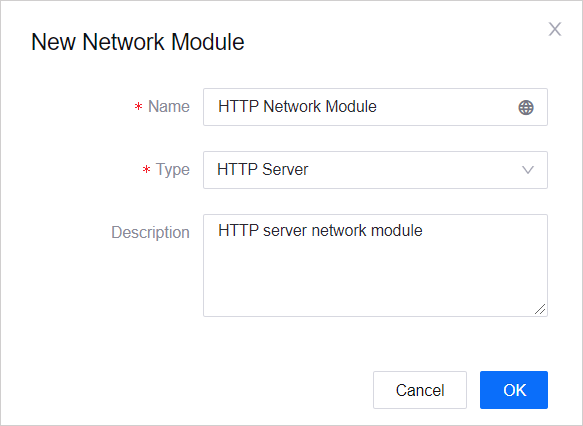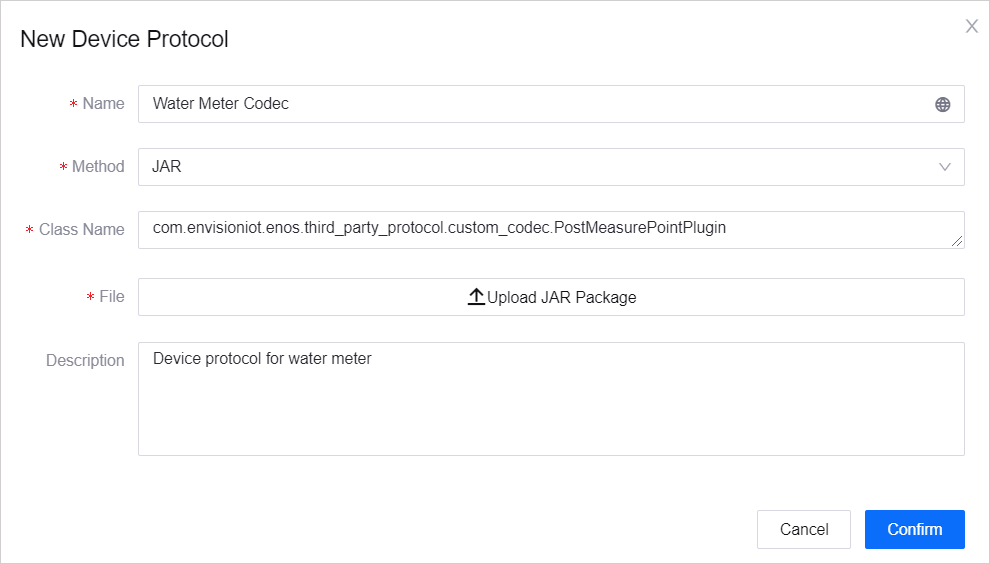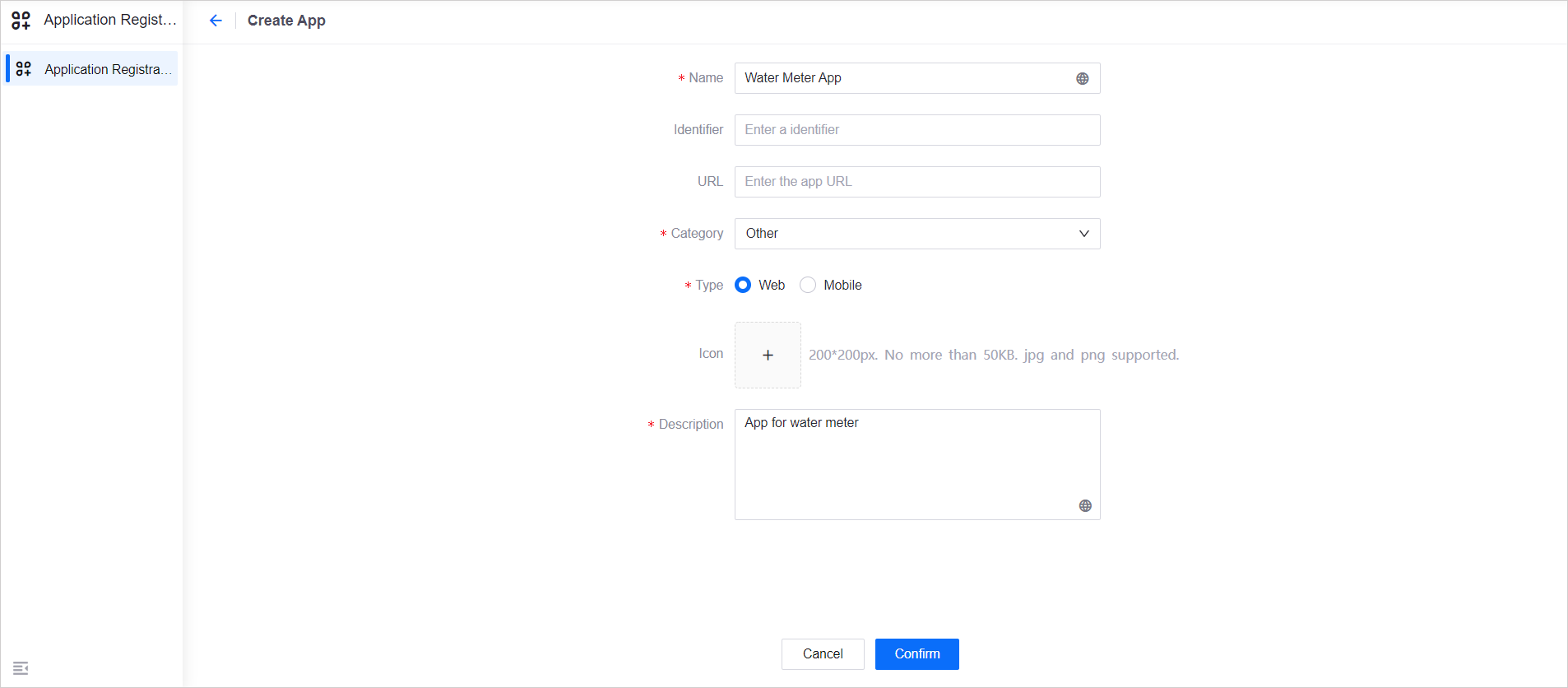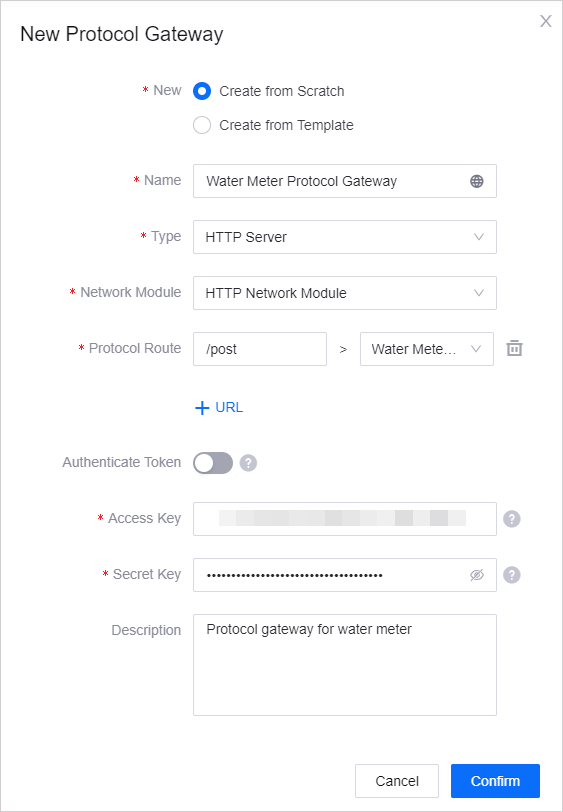Unit 2: Device Onboarding¶
To onboard a device using a protocol gateway, you need to first create a HTTP network module to upload data, a device protocol used to process the device onboarding protocol, and a protocol gateway to analyze and update the data.
Step 1: Creating a Network Module¶
In EnOS Management Console, select Device Onboarding > Network Modules.
Click New Network Module, and enter the following in the New Network Module window.
Name: HTTP Network Module
Type: HTTP Server
Description: HTTP server network module
Click OK to save the configuration.

For more information, see Network Modules.
Step 2: Creating a Device Protocol¶
In order to convert the data of the reported message, you need to create a method to “translate” the upstream data. This is done by following the method defined in https://github.com/EnvisionIot/third-party-protocol, and indicate the method that implements the ICodecPlugin into a JAR package.
For more information, see Device Protocols.
JAR Package¶
Include the dependency by adding the following code snippet.
<dependency> <groupId>com.envisioniot.enos.third_party_protocol</groupId> <artifactId>core</artifactId> <version>1.0.0</version> </dependency>
Use the example code below to serialize the JSON data reported by the device into an object and obtain the measurement point information to report.
CustomData Class
package com.envisioniot.enos.third_party_protocol.custom_codec.data; import lombok.AllArgsConstructor; import lombok.Data; import lombok.NoArgsConstructor; import java.util.List; @Data @NoArgsConstructor @AllArgsConstructor public class CustomData { private String identifier; private String msgType; private Integer hasMore; private Integer dtag; private List<ServiceItem> data; }
ServiceItem Class
package com.envisioniot.enos.third_party_protocol.custom_codec.data; import lombok.AllArgsConstructor; import lombok.Data; import lombok.NoArgsConstructor; import java.util.Map; @Data @NoArgsConstructor @AllArgsConstructor public class ServiceItem { private String serviceId; private Map<String, Object> serviceData; private Long eventTime; }
PostMeasurePointPlugin Class
package com.envisioniot.enos.third_party_protocol.custom_codec; import com.alibaba.fastjson.JSON; import com.envisioniot.enos.third_party_protocol.core.ICodecPlugin; import com.envisioniot.enos.third_party_protocol.core.element.PostedMeasurePoints; import com.envisioniot.enos.third_party_protocol.core.message.request.PostMeasurePointRequest; import com.envisioniot.enos.third_party_protocol.core.message.response.PostMeasurePointRspItemData; import com.envisioniot.enos.third_party_protocol.core.message.response.Response; import com.envisioniot.enos.third_party_protocol.custom_codec.data.CustomData; import com.envisioniot.enos.third_party_protocol.custom_codec.data.ServiceItem; import lombok.extern.slf4j.Slf4j; import java.util.*; @Slf4j public class PostMeasurePointPlugin implements ICodecPlugin<PostMeasurePointRequest, PostMeasurePointRspItemData> { private static final String FLOW_FIELD = "flow"; private static final String INTERNAL_TEMPERATURE_FIELD = "internalTemperature"; @Override public String getProtocol() { return "custom protocol"; } @Override public PostMeasurePointRequest decode(Map<String, Object> meta, String originalReq) { try { final CustomData customData = JSON.parseObject(originalReq, CustomData.class); final String assetId = customData.getIdentifier(); PostMeasurePointRequest request = new PostMeasurePointRequest(); request.setIgnoreInvalidMeasurePoint(true); request.setRealtime(true); PostedMeasurePoints point = new PostedMeasurePoints(); point.setAssetId(assetId); Map<String, Object> measurepoint = new HashMap<>(); for (ServiceItem item : customData.getData()) { Map<String, Object> serviceData = item.getServiceData(); try{ final Integer flow = (Integer) serviceData.get(FLOW_FIELD); if (Objects.nonNull(flow)) { measurepoint.put(FLOW_FIELD, flow); } } catch (Throwable t) { log.warn( "convert data failed, field: {}, original data: {}", FLOW_FIELD, serviceData.get(FLOW_FIELD)); } try{ final String internalTemperature = (String) serviceData.get(INTERNAL_TEMPERATURE_FIELD); if (Objects.nonNull(internalTemperature)) { final Long numberOfTemperature = Long.valueOf(internalTemperature); measurepoint.put(INTERNAL_TEMPERATURE_FIELD, numberOfTemperature); } } catch (Throwable t) { log.warn( "convert data failed, field: {}, original data: {}", INTERNAL_TEMPERATURE_FIELD, serviceData.get(INTERNAL_TEMPERATURE_FIELD)); } } point.setMeasurepoints(measurepoint); List<PostedMeasurePoints> measurepoints = new ArrayList<>(); measurepoints.add(point); request.setMeasurepoints(measurepoints); return request; } catch (Throwable t) { log.error("fail to decode request, originalReq: {}", originalReq, t); return null; } } @Override public String encodeResponse(Map<String, Object> meta, String originalReq, Response<PostMeasurePointRspItemData> response) { return JSON.toJSONString(response); } }
Package the above into a JAR file.
Device Protocol¶
In EnOS Management Console, select Device Onboarding > Device Protocols.
Click New Device Protocol, and enter the following in the New Device Protocol window.
Name: Water Meter Codec
Method: JAR
Class Name: com.envisioniot.enos.third_party_protocol.custom_codec.PostMeasurePointPlugin
File: Upload the JAR file created above.
Description: Device protocol for water meter
Click Confirm to save the configuration.

Step 3: Creating a Protocol Gateway¶
Since the protocol gateway involves permission verification, before creating the protocol gateway, you need to create an application that can be used, and give the application read and write permissions for the device.
For more information, see Protocol Gateways.
Application¶
In EnOS Management Console, select Application Registration.
Click Create App, and enter the following in the Create App page.
Name: Water Meter App
Category: Other
Type: Web
Description: App for water meter
Click Confirm to save the configuration.

Protocol Gateway¶
In EnOS Management Console, select Device Onboarding > Protocol Gateways.
Click New Protocol Gateway, and enter the following in the New Protocol Gateway window.
New: Create from Scratch
Name: Water Meter Protocol Gateway
Type: HTTP Server
Network Module: HTTP Network Module
Protocol Route: /post > Water Meter Codec
Access Key: The access key of the application created above.
Secret Key: The secret key of the application created above.
Description: Protocol gateway for water meter
Click Confirm to save the configuration and the system will generate a protcol gateway ID.
